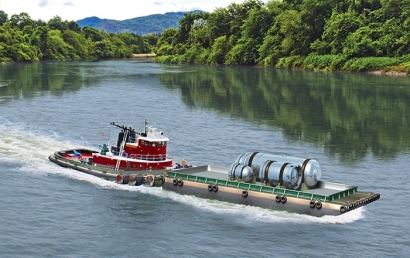
All we seem to hear about nuclear power is the negatives — the risk of a meltdown like the disaster in Fukushima or the difficulty in disposing of spent fuel rods from the reactors. Some industry experts are trying to dispel these negative stereotypes. Is it possible that the next wave of renewable energy could be small-scale nuclear devices?
When we say "small-scale nuclear," we're not talking about something that might fit in your garage. These small modular reactors, or SMRs, consist of eight-meter-tall cylinders that hold individual nuclear reactors. They're substantially smaller than traditional reactors. A full-scale nuclear reactor can generate more than a gigawatt of energy, while each of these SMRs only generates 60 megawatts each.
These mini reactors are the brainchild of NuScale Power, a company based in Corvallis, Oregon. Currently, these SMRs only exist as computer models, though they do have a single non-functional mockup.
The major difference is that engineers can create an entire power plant by setting up a series of these modular reactors side by side. From above, it might look like a six-pack of beer or a double-line of Christmas nutcrackers standing in a row — a far cry from the squat buildings and massive cooling towers that we're so familiar with.
The biggest difference between these modular reactors and their larger counterparts is the fact that they are supposedly meltdown-proof. They will be equipped with additional safety features, as well as simplified designs so there are fewer moving parts that could possibly fail. They can even be disconnected from the grid individually in case of an emergency, allowing the rest of the module to continue functioning normally At a time when efficiency and government rebates and assistance matter more than ever, developing more safe and efficient energy technologies is imperative.
They will also cost less than traditional nuclear reactors. A standard gigawatt-generating nuclear plant can cost between $6 billion and $9 billion to construct. A NuScale modular reactor that will generate comparable levels of power will cost around $3 billion to build.
NuScale, and the United States in general, aren't the only ones interested in modular nuclear reactors as a green alternative for power generation. Russia launched a small SMR that can generate 70 megawatts from its location in the Arctic Ocean. China released plans for a floating SMR in 2016, started construction in 2019 and is planning to have their first fully functional reactor online by 2025. Canada and the U.K. are also working on modular reactor projects.
In the U.S., NuScale is planning to have their first reactor complete and online around 2026 in the state of Idaho. They're planning to break ground sometime within the next two years.
Is the future of renewable energy appearing in the form of small-scale nuclear reactors? It's a little too early to tell, since most of the small modular reactors appearing around the world won't be online for a few years. The early models and projections are all optimistic.
The biggest challenge likely won't be engineering or construction. The biggest challenge will be overcoming the negative public image that currently surrounds nuclear power technology. It may be a cleaner option than fossil fuels, but many communities would rather have a coal plant than a nuclear one because the technology is surrounded by negative press.
Still, this push toward the creation of small-scale nuclear reactors will likely shape the next phase of renewable energy generation, and we may see more of them in the coming years.

